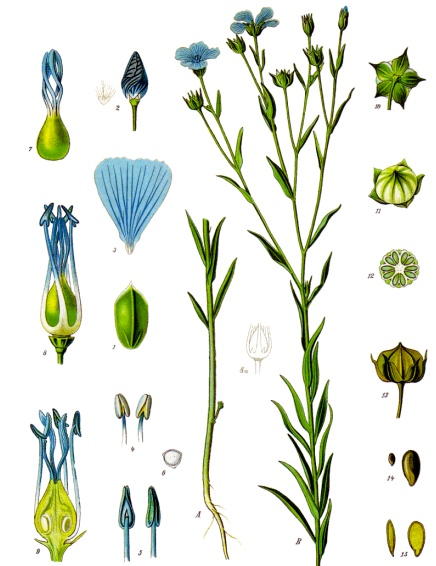
Linum usitatissimum (L)
Synonyms: flaxseed, common flax, lint bells,
winterlien
Order: Linaceae
Description: Linum is an erect annual herb with a glabrous stem and few branches, growing about 60cm in height and cultivated in most temperate and tropical regions. The stem bears alternate, sessile, simple entire lanceolate to oblong leaves. Each branch produces one or two violet-blue five-petalled flowers in a terminal cluster from June to August, and a globular capsule containing about ten seeds.
Parts used: ripe seeds and their expressed oil
Collection: when fully ripe in September.
Constituents: 30-40% fixed oil including linoleic, linolenic and oleic acids, mucilage (6%), protein (25%), the cyanogenic glycoside linamarine, bitter principle; the oil contains vitamins A, B, D and E, minerals and amino acids.
Actions: demulcent, antitussive, gentle bulk laxative, emollient, anodyne, resolvent, relaxing expectorant, antiseptic, anti-inflammatory, locally drawing, soothing and healing, antitussive, pectoral
Indications: Respiratory catarrh, bronchitis, furunculosis, pleuritic pains
Therapeutics and Pharmacology: Linum may be used in all pulmonary infections, particularly where there is much catarrh, as in bronchitis. It is often applied as a poultice in pleurisy and other pulmonary conditions. A poultice may also be applied to boils and carbuncles, shingles, psoriasis and burns. Linum is also used in chronic or acute, atonic or spastic constipation. Whilst not a true laxative, it acts as a bulking and lubricating agent causing no irritation. Linseed oil is an valuable source of essential fatty acids which can help prevent the build-up of fatty deposits in the tissues. The oil has also been used to help the passage of gallstones.
Combinations: As a poultice for the chest Linum combines well with Sinapsis alba. For boils, localised swellings and inflammations it may be combined with Lobelia, Althaea root and Ulmus as a poultice.
Caution: Only the ripe seeds should be used; immature seeds can cause poisoning as they contain traces of prussic acid. Linseed oil deteriorates rapidly. It is important to stress to anyone taking linseed that at least two glasses of water should be taken at the same time to ensure proper swelling of the linseed in the stomach. In many cases where linseed appears to fail, the reason is that not enough fluid has been taken.
Preparation and Dosage:
Regulatory status GSL
Crushed or entire seeds: 3-6g or by infusion
Oil: 5-30ml, in vehicle, as a purgative
Additional Comments: As the source of linen fibre, Linum has been cultivated since at least 5000 BC; today it is mainly grown for its oil. It was used by the Egyptians to make cloth in which to wrap their mummies, and the Bible contains many references to the plant. The medicinal properties of the seeds were known to the Greeks and Hippocrates recommended them for inflammations of the mucous membranes. In 8th century France, Charlemagne passed laws requiring the seeds to be consumed to keep his subjects healthy. Linseed oil is used as a purgative for sheep and horses. Flax is obtained from the stem fibres. The oil has a number of uses in the paint and other industries. It is also used in cooking and has been recommended to help leach toxic heavy metals such as aluminium from the body.
Bibliography
BHMA 1983 British Herbal Pharmacopoeia, BHMA, Bournemouth.
Grieve, M. 1931 A Modern Herbal, (ed. C.F. Leyel 1985), London.
Hoffmann, D. 1990 The New Holistic Herbal, Second Edition, Element, Shaftesbury.
Lust, J. 1990 The Herb Book, Bantam, London.
Mabey, R. (ed.) 1991 The Complete New Herbal, Penguin, London.
Mills, S.Y. 1993 The A-Z of Modern Herbalism, Diamond Books, London.
Ody, P. 1993 The Herb Society's Complete Medicinal Herbal, Dorling Kindersley, London.
Polunin, M. and Robbins, C. 1992 The Natural Pharmacy, Dorling Kindersley, London.
Weiss, R.F. 1991 Herbal Medicine, Beaconsfield Arcanum, Beaconsfield.
Wren, R.C. 1988 Potter's New Cyclopaedia of Botanical Drugs and Preparations, C.W.Daniel, Saffron Walden.










